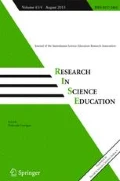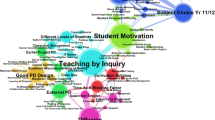Abstract
A central concern in science education is promoting inquiry activities, and a significant amount of research in science education has addressed what inhibits this goal. However, this research has tended to be focused on implementation issues. Levels of implementation are correlated with extrinsic barriers such as time, resources and teacher knowledge, but the internal structure of inquiry remains unexamined. However, are there also some ways in which inquiry based instruction is intrinsically difficult? That is, given perfect conditions for implementation, is devising inquiry activities a non-trivial matter, and are there patterns to the difficulties in doing so? The aim of this paper is to provide both a theoretical and empirical basis for the intrinsic problems associated with the construction of inquiry activities. We present a theoretical framework that connects contemporary studies of science to the classroom context. We then examine a case study of teacher education students designing inquiry-based instruction to demonstrate empirical evidence of intrinsic problems. Our ultimate goal is to improve our ability as teacher educators to guide science teachers in fulfilling this central task of their work.

Similar content being viewed by others
Notes
We should note that heterogeneous classrooms, as traditionally structured, are not a solution here. Such classrooms have students of diverse abilities, but not science classroom experience.
There was one additional code – meta – indicating a conflict about their own process that will not be discussed here.
Counts of each code are not reported since such counts would be meaningless. As noted in the discussion of our methodology, each trigger utterance was coded, even though multiple trigger utterances were arguably indicators of the same hurdle. This was to insure that every possible hurdle was examined.
We originally referred to all of these categories as barriers. However, we later felt that a key distinction between extrinsic problems and intrinsic problems is that extrinsic problems are barriers to be removed, while intrinsic impediments are hurdles to overcome.
References
Anderson, R. D. (2002). Reforming science teaching: what research says about inquiry. Journal of Science Teacher Education, 13(1), 1–12.
Anderson, R. D. (2007). Inquiry as an organizing theme for science curricula. In S. K. Abell & N. G. Lederman (Eds.), Handbook of research on science education (pp. 807–830). Mahwah: Lawence Erlbaum Associates.
Collins, H. M. (1975). The seven sexes: a study in the sociology of a phenomenon, or the replication of experiments in physics. Sociology, 9, 205–224.
Collins, H. M. (1981a). Son of seven sexes: the social destruction of a physical phenomenon. Social Studies of Science, 11, 33–62.
Collins, H. M. (1981b). Stages in the empirical programme of relativism. Social Studies of Science, 11, 3–10.
Collins, H. M. (1985). Changing order: Replication and induction in scientific practice. Chicago: The University of Chicago Press.
Eick, C., & Reed, C. (2002). What makes an inquiry-oriented science teacher? The influence of learning histories on student teacher role identity and practice. Science Education, 86, 401–416.
Glaser, B. G. (1969). The constant comparative method of qualitative analysis. In G. L. McCall & J. L. Simmons (Eds.), Issues in participant observation: A text and reader (pp. 216–227). Reading: Addison-Wesley.
Hofstein, A., Navon, O., Kipnis, M., & Mamlok-Naaman, R. (2004). Developing students’ ability to ask more and better questions resulting from inquiry-type chemistry laboratories. Journal of Research in Science Teaching, 42(7), 791–806.
Kanter, D. E. (2010). Doing the project and learning the content: designing project-based science curricula for meaningful understanding. Science Education, 94, 525–551.
Krauss, R. (2008). Inquiry teaching methods: A multiple-case study. Chicago: Illinois Institute of Technology.
Kuhn, T. S. (1970). The structure of scientific revolutions. Chicago: University of Chicago.
Lave, J., & Wenger, E. (1991). Situated learning: Legitimate peripheral participation. Cambridge: Cambridge University Press.
Lederman, N. G. (1999). Teachers’ understanding of the nature of science and classroom practice: Factors that facilitate or impede the relationship. Journal of Research in Science Teaching, 36(8), 916–929.
Lotter, C., Harwood, W., & Bonner, J. (2006). Overcoming a learning bottleneck: inquiry professional development for secondary science teachers. Journal of Science Teacher Education, 17, 185–216.
Meyer, D. Z. (2003). Social Engagement in Curriculum Design. Unpublished Doctoral Dissertation, Cornell University, Ithaca, NY.
Minstrell, J., & van Zee, E. (Eds.). (2000). Inquiring into inquiry learning and teaching in science. Washington, D.C.: American Association for the Advancement of Science.
National Research Council. (1996). National science education standards. Washington: National Academy Press.
National Research Council. (2000). Inquiry and the national science education standards. Washington, DC: Naional Academy Press.
Pinch, T. (1981). The sun-set: the presentation of certainty in scientific life. Social Studies of Science, 11, 131–158.
Pinch, T. (1985). Towards an analysis of scientific observation: the externality and evidential significance of observational reports in physics. Social Studies of Science, 15, 3–36.
Pinch, T., & Bijker, W. (1987). The social construction of facts and artefacts: Or how the sociology of science and the sociology of technology might benefit each other. In W. E. Bijker, T. P. Hughes, & T. J. Pinch (Eds.), The social construction of technological systems (pp. 17–50). Cambridge: MIT.
Roehrig, G. H., & Luft, J. A. (2004). Constraints experienced by beginning secondary science teachers in implementing scientific inquiry lessons. International Journal of Science Education, 26(1), 3–24.
Rowell, P. M. (2004). Shaping school science: competing discourses in an inquiry-based elementary program. International Journal for Learning Technologies, 26, 915–934.
Viennot, L., & Rainson, S. (1999). Design and evaluation of a research-based teaching sequence: the superposition of electric field. International Journal of Science Education, 21(1), 1–16.
Acknowledgements
The authors would like to thank Norman Lederman, Stephan Bartos and Jeanine Meyer for reviewing drafts of the paper.
Author information
Authors and Affiliations
Corresponding author
Rights and permissions
About this article
Cite this article
Meyer, D.Z., Antink Meyer, A., Nabb, K.A. et al. A Theoretical and Empirical Exploration of Intrinsic Problems in Designing Inquiry Activities. Res Sci Educ 43, 57–76 (2013). https://doi.org/10.1007/s11165-011-9243-4
Published:
Issue Date:
DOI: https://doi.org/10.1007/s11165-011-9243-4




